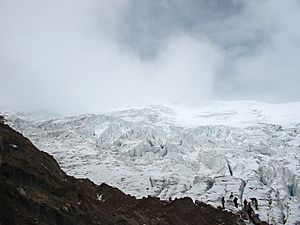Cayambe (volcano) facts for kids
Quick facts for kids Cayambe |
|
|---|---|

North face of the Cayambe volcano
|
|
| Highest point | |
| Elevation | 5,790 m (18,996 ft) |
| Prominence | 2,075 m (6,808 ft) |
| Listing | Ultra |
| Geography | |
| Location | Pichincha, Ecuador |
| Parent range | Andes |
| Geology | |
| Mountain type | Complex volcano |
| Volcanic arc/belt | North Volcanic Zone |
| Last eruption | 1785 to 1786 |
| Climbing | |
| First ascent | 1880 by Edward Whymper |
| Easiest route | rock/snow climb |
Cayambe, also called Volcán Cayambe, is a huge volcano in Ecuador. It is part of the Andes mountains, which stretch across South America. You can find it in Pichincha Province, about 70 kilometers (43 miles) northeast of Quito, the capital city. Cayambe is the third-highest mountain in Ecuador, reaching an amazing 5,790 meters (19,000 feet) above sea level.
This incredible volcano always has a cap of snow and ice on its top. It's a Holocene volcano, meaning it formed in the last 11,700 years. Cayambe last erupted a long time ago, between 1785 and 1786.
What makes Cayambe extra special is that its south side is the highest point in the world that the Equator crosses. It's also the only place on the Equator that has snow and ice! The ice cap covers about 22 square kilometers (8.5 square miles). There are large glaciers (rivers of ice) on its eastern side. Most of the volcano and its slopes are protected within the Cayambe Coca Ecological Reserve.
Exploring Cayambe
First Climbers
The first people to climb Cayambe were a British adventurer named Edward Whymper and his two Italian guides, Jean-Antoine Carrel and Louis Carrel. They reached the top in 1880. These brave climbers were also the first to reach the summits of many other volcanoes in Ecuador.
Climbing Today
Even today, Cayambe is a favorite mountain for climbers. The main path to the top goes through a snowy area with some cracks. The climb gets steeper near the very end, reaching a 45-degree slope. There's a big crack in the glacier called a bergschrund that climbers must cross at about 5,500 meters (18,000 feet).
Near the summit, climbers face more cracks and ice towers called seracs. But the views from the top are truly amazing!
Cayambe in Art and Science
The famous explorer Alexander von Humboldt thought Cayambe was especially beautiful. His writings inspired a painter named Frederic Edwin Church to create a painting of the peak. This painting later became part of his famous work, The Heart of the Andes.
Here's a cool science fact about Cayambe: Its peak is the point on Earth's surface that is farthest from the Earth's center. This means that as our planet spins, the top of Cayambe actually moves the fastest!
See also
 In Spanish: Volcán Cayambe para niños
In Spanish: Volcán Cayambe para niños
- Lists of volcanoes
- List of volcanoes in Ecuador




